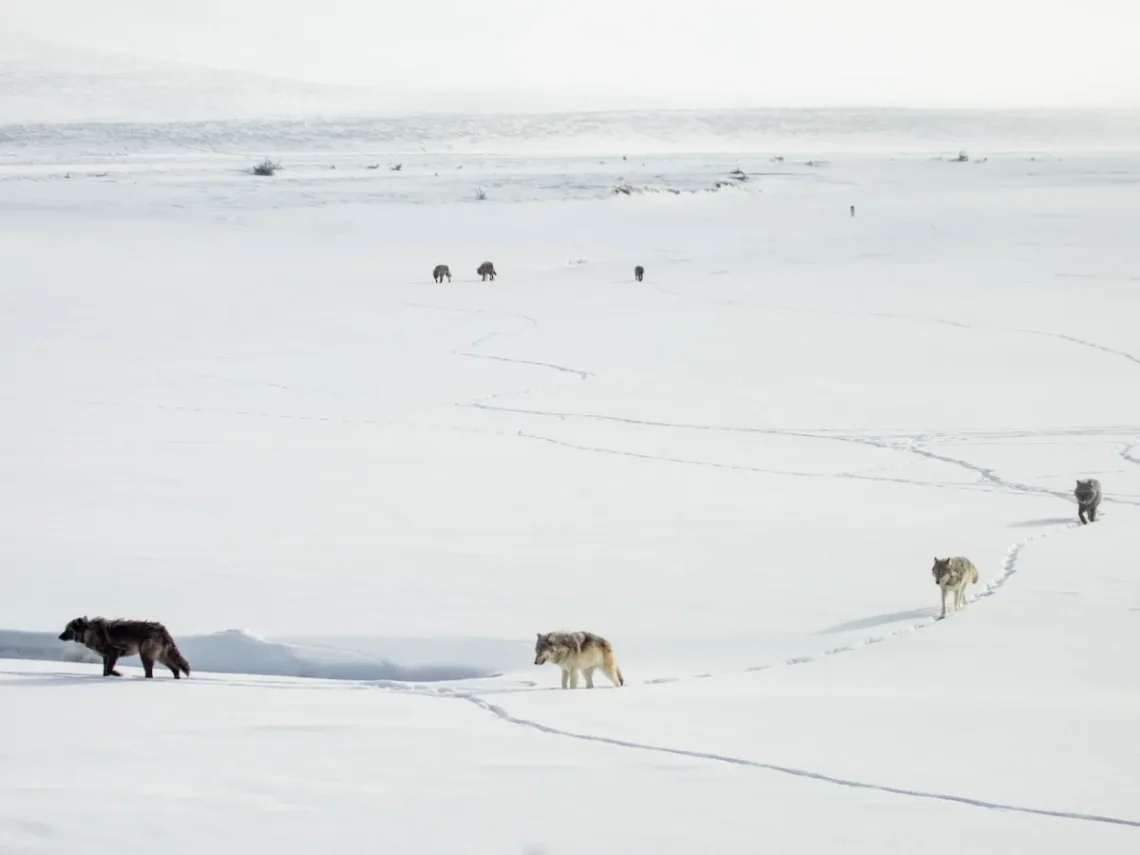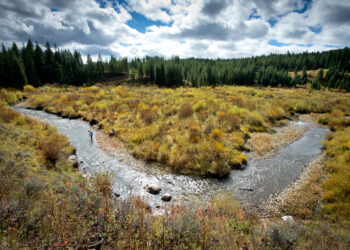Crossing Yellowstone National Park’s protective boundary, an apex predator becomes prey. These wolves don’t last long in the modern Mountain West.
By Mike Koshmrl and Nick Mott WYOFILE, MOUNTAIN JOURNAL
If not for a series of tones broadcasting her location, no one would’ve known she had died.
Like dozens of other Yellowstone National Park wolves involved in a three-decade-long study, researchers collared wolf 1331F as a pup in 2021 to track her movements. Gray with ribbons of brown fur fading into her pale muzzle and legs, the young wolf lived with the Wapiti Lake Pack, one of the largest in Yellowstone.
Wildlife photographer V.C. Wald watched 1331 supervise black wolf pups hunting a wounded bison on the shore of the Gibbon River in the winter of 2023-’24. Easily visible from the road, the pups tried to take the bison head-on, only to scatter as it bluff charged. Then, 1331 demonstrated how to approach the massive ungulate more safely from behind, nipping at its hind quarters, Wald recalls, “[she was] a teacher, of young wolves, and of me.”

The scene isn’t out of the ordinary for the Wapiti Lake Pack, whose territory encompasses Yellowstone’s sagebrush-covered Hayden Valley in the center of the park. They chase elk and bison. They play and sun themselves on cold winter days. Much of this activity occurs under the gaze of humans. But every now and then, pack members leave the park.
In late 2024, Yellowstone Wolf Project telemetry data suggest 1331 started a journey away from her pack. She headed north. First, she spent time around Mammoth Hot Springs. Then she crossed the park’s boundary into Montana. While tourists often lined roads to watch 1331 and her packmates inside the park, wolf watchers are sparser in the rugged and mountainous mix of public and private land just north of Yellowstone. Wolf 1331 had no way of knowing, but she’d crossed an invisible line where the national park gives way to state rule. It’s a consequential threshold: Wolves are protected from hunting on one side, but can be legally killed by gun, trap or snare on the other.
Park officials don’t know if 1331 was permanently leaving her pack or if she would have eventually returned to Wapiti Lake’s territory; it’s not uncommon for female wolves of her age to disperse for days or even weeks leading up to breeding season in February — sort of a lupine rumspringa. But they do know she’d left the pack far behind. On Jan. 24, 2025, staff with the Yellowstone Wolf Project drove north of the park, wielding bulky telemetry equipment to listen for collared elk and wolves. They heard 1331’s signal, indicating she’d moved farther into Montana than ever. But, the beeps suggested, she hadn’t budged in at least 12 hours.
Park staff turned the information over to Montana’s fish and game agency. Wolf 1331 would ultimately be found dead in a trap set by a prolific wolf hunter who manages a large ranch about 10 miles north of Yellowstone. The man who trapped 1331 would receive a warning for violating state trap-check laws and no other punishment. Her journey had come to an end roughly a month after it began.
The Yellowstone bubble
Wolf 1331F’s fate was unusual only in that she made it so far north. When wolves leave the park, they die — often, quickly.
Yellowstone’s roughly 100 wolves are among the most famous and beloved in the world, attracting throngs of wolf-admiring tourists who spend tens of millions of dollars in the region every year. However, protected by federal law and tolerant of their adoring fans, Yellowstone wolves are uniquely vulnerable to hunters and trappers in surrounding states where killing wolves is legal. Their destinies are often shaped by which of the three surrounding state boundaries they cross.
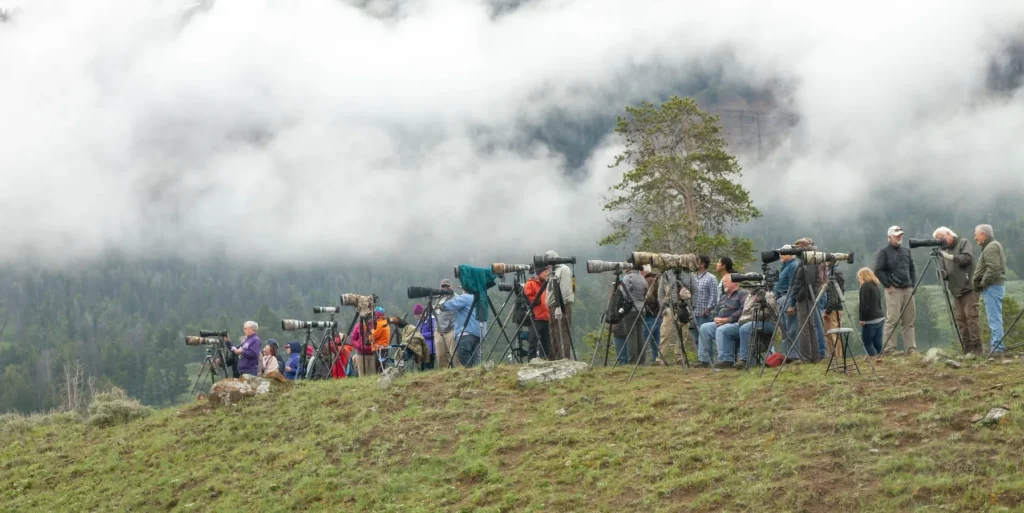
“When we look at the fate of collared wolves that leave Yellowstone, most commonly they don’t survive the next hunting season,” Yellowstone Wolf Project leader Dan Stahler said in a May 2024 interview.
Heading into Wyoming, wolves encounter wilderness and tightly controlled hunts, but greater danger beyond. Step into Idaho and it’s a free-fire zone, though few wolves go that way. Journeys north into Montana are the most common and have proven the most deadly, despite some state efforts to take it easy on park wolves.
Yellowstone’s wolves die from hunting and trapping outside the park every season, but things seem to be getting worse. From 2009-2020, about 4.3 wolves from Yellowstone were killed legally by hunters and trappers each year, according to National Park Service data. From 2021-2024, that number nearly tripled when an average of 12.75 wolves died annually, according to Yellowstone Wolf Project data.
It was clear to Doug Smith, retired lead of the Yellowstone Wolf Project, that the park’s porous boundaries would be an issue almost immediately after wolves were reintroduced in 1995. “This is a long-term problem for wildlife management, and particularly wolves,” Smith said in an interview this fall.
Inside Yellowstone, wolves are managed “for the benefit and enjoyment of the people,” the now-famous language adorning the top of Roosevelt Arch, a striking stone gateway often surrounded by selfie-taking tourists at the park’s North Entrance. The sentiment springs from the 1916 act creating the National Park Service and stops at the park’s border. Outside Yellowstone, the states take over wolf management. There, wolves can get into trouble. They kill livestock, the occasional pet, and lots and lots of elk. And they’re especially naive to the many dangers in the new world around them.
Even in the early days of reintroduction, Smith remembers phone calls urging him to do the impossible: keep wolves inside the park. Back then, wolves had federal protections both in and out of Yellowstone. Hunting them was illegal, whether in Montana, Wyoming or Idaho, or inside Yellowstone itself. But within a month of releasing the park’s first wolves from their enclosure, a hunter named Chad McKittrick illegally shot and killed a male wolf, numbered 10M, after it left the park and ventured onto private land near Red Lodge, Montana.
Fast-forward nearly 30 years and death also awaited 1329M, a striking green-eyed black male wolf, when he left Yellowstone. Researchers captured and collared 1329, born into the Wapiti Lake Pack just like 1331F. He was caught and joined the ranks of research wolves in 2021, the same year they collared 1331F as a pup. A year later, park scientists documented the young male, with a touch of silver on his chin, getting into a scuffle with other males, which could have spurred a dispersal. His collar’s GPS data shows he left Yellowstone on May 14, 2022, heading south. “[1329] beelined it all the way down through the trophy game wolf area,” said Stahler, the current Yellowstone Wolf Project leader.
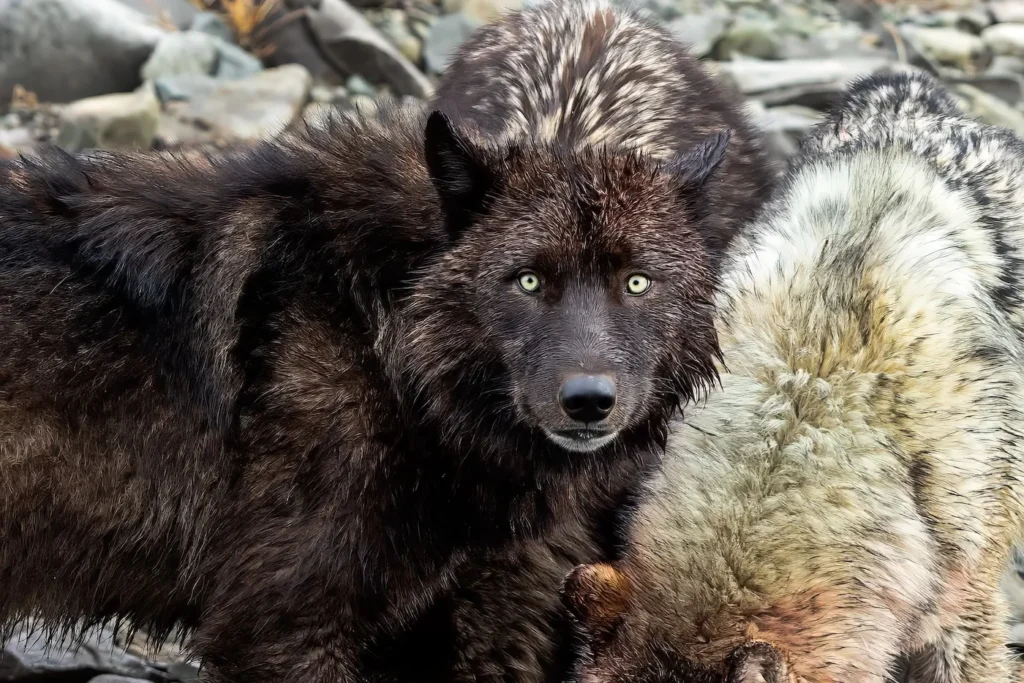
The state of Wyoming tightly regulates wolf hunting in an area where wolves are managed as “trophy game” adjacent to Yellowstone and Grand Teton national parks, with the area closed to hunting in the spring. But 1329 kept moving. GPS data shows his route, loping straight through the heart of Jackson Hole, then south, looping through the Wyoming and Salt River ranges. The black wolf headed into a valley where, three years later, Sublette County resident Cody Roberts would fight a felony animal cruelty charge for allegedly making a public spectacle of a wounded, juvenile wolf in a bar before the animal died. The incident made international news and divided the small Western Wyoming community. Wolves are fewer here. There’s a reason.
Within two weeks of leaving Yellowstone, the roughly 2-year-old 1329 crossed another boundary and left Wyoming’s regulated wolf “trophy game” area for its “predator zone,” which covers 85% of the state and where there are virtually no regulations on how wolves can be killed. Running down and bludgeoning wolves with snowmobiles here is legal. The departure meant he could be killed any time of year, by almost any means, and without a license.
Toward the end of June 2022, wolf 1329 stopped moving in the mountains near Salt River Pass, near where the southern Greater Yellowstone Ecosystem transitions into the Great Basin. He’d stepped into a steel-jawed leghold trap. “It had been in the trap about four days,” Stahler says, “based on the location and movement.” By June 26, the trapped wolf was dead. The Yellowstone biologist’s best guess is that 1329 was exposed to the elements and died of dehydration. States surrounding the park require trappers to frequently check their wolf traps to reduce animals’ suffering and minimize harm to non-target species. Negligence is illegal.
‘Risky life choice’
Wolves in the Northern Rockies are no strangers to controversy. Indeed, politicians in all three states surrounding Yellowstone have long seized on wolves as a prime example of federal overreach. “I remain seriously concerned with the uncertainty that continues to surround Yellowstone wolf reintroduction as it moves forward,” former Wyoming Gov. Jim Geringer wrote to U.S. Secretary of the Interior Bruce Babbitt in 1995, after wolves were already on the ground. Former Idaho Gov. Butch Otter said he’d be the first to bid on a wolf tag back in 2007. And Montana Gov. Greg Gianforte was issued a warning for killing a Yellowstone wolf without the proper trapper education in 2021.
Death by hunting, trapping or wildlife management official is the most common fate for wolves that leave Yellowstone National Park. Even in a natural system, the act of dispersing is already a “risky life choice,” according to Stahler. Solo wolves end up in territories of other wolf packs, where they clash and get killed. In fact, within Yellowstone, wolves are the leading cause of wolf death.
While the number of wolves that spend the vast majority of their time inside Yellowstone has stayed relatively static for more than two decades, wolf populations outside the park have grown by leaps and bounds. That’s in part because some Yellowstone wolves successfully dispersed and survived. At the same time, other wolves reintroduced in Idaho’s Frank Church-River of No Return Wilderness established and bred. And yet more wolves filtered down from the north, crossing the Canadian border into the U.S. Today, populations of animals as reclusive as wolves are tough to estimate, but the most recent figures for Montana and Idaho wolf populations are roughly 1,100 and 1,200, respectively. In Wyoming, which has less mountainous, treed habitat, there are fewer wolves — about 350 — and they’re counted with much greater precision.
While those wolf populations outside the park grew, the human population inside Yellowstone expanded, too. Park visitation hovered around 3 million annually at the time of wolf reintroduction in 1995. Today, that number is closer to 5 million, evidenced by the sprawl of souvenir shops in the Yellowstone gateway towns of Jackson, Wyoming and Gardiner, Montana where tourists snap up T-shirts, stuffed bison and elk toys, and art emblazoned with wolves. This increased visitation, wolf biologist Smith says, is the biggest issue facing Yellowstone National Park as a whole.
“It’s the best place in the world to view wild wolves,” says Smith, adding that in the early days of wolf reintroduction, finding wolves inside the park was exclusive, inside information. That’s changed nowadays, he says, with the influx of eager, wolf- and grizzly-watching tourists. “There’s no inside tips anymore. Just look for the traffic jam.”
Wolf-watching tourism alone contributes at least $82 million annually to communities bordering the park, the most recent data show. However, all those people lining the roads and hillsides of Yellowstone come at a cost. “[When wolves] leave the park,” Smith says, “they get shot because they stand there and look at a hunter.”
Some wolves become so accustomed to people that they become habituated, according to Smith, meaning they walk up to humans in search of food or become so bold that they run off with tripods. In rare instances, park officials have euthanized habituated wolves.
The Wapiti Lake Pack, a major draw for wolf watchers and tourists, has been susceptible to human conditioning. These Yellowstone interior wolves, considered bison-killing specialists, often use groomed park roads to get around in winter, at times walking right by snowmobilers buzzing down the road on their way to places like Old Faithful or Tower Junction. They’ve even been hazed with paintballs as a result.
But the vast majority of park wolves aren’t habituated, Smith says. Rather, they’re tolerant of people. “A wild wolf is avoidant,” he says. “They flee, they run. They know what humans mean: death. That’s not a park wolf.” Tolerance is the curse that leaves them vulnerable outside the park.
Justin Webb, executive director of the Foundation for Wildlife Management, says Yellowstone should do more to instill its wolves with a healthy fear of people.
“Wolves in the park should be given the respect of space, and I think that those wolves shouldn’t be conditioned to people,” says Webb, whose nonprofit makes bounty-like payments to trappers who kill wolves.
On occasion, Yellowstone wolves face circumstances that make them especially prone to human conditioning. The Junction Butte Pack, for example, often dens within eyeshot of Slough Creek, a popular trailhead for hikers and anglers. Tourists and Yellowstone guides have learned about the highly visible location, potentially dooming those pups.
“Why don’t they close the trailhead down?” Webb asked.
Yellowstone wolves leave the park for all kinds of reasons. Some, like 1331F, might take a temporary solo hiatus from their pack, while 1329M was likely in the midst of a more permanent dispersal, searching for new territory or a mate. However, the vast majority of Yellowstone’s wolves spend about 96% of their time inside the park, collar data shows. With no time to learn a healthy fear of humans, the 4% of the time they unwittingly leave their protections behind proves deadly. Instead of other wolves, people — either hunters or poachers — become, by far, the leading cause of death for wolves that depart Yellowstone, Stahler said.
No fear
For the first decade and a half after wolves returned to Yellowstone, the Endangered Species Act outlawed hunting wolves throughout the Lower 48. Protracted legal battles meant the first lawful hunt didn’t occur until 2009, and it revealed the risk facing wolves that spend most of their lives inside Yellowstone.
“They aren’t showing any fear,” one Montana wolf hunter told the Los Angeles Times after a successful hunt that year. “But they will, I’m sure.” Another hunting guide told the outlet about a wolf his client killed: “He was no more afraid of [the hunter] than the man in the moon.”
In 2011, wolves were permanently “delisted,” or stripped of federal protections under the Endangered Species Act, in Montana, Idaho and portions of three other western states by an act of Congress. In Wyoming, the change came more slowly because of litigation. Wolves were most recently delisted there in 2017.
After years of hunts in surrounding states, the story hasn’t changed much. In late 2024, members of the 8 Mile Pack crossed the park boundary into Montana. Three hunters were waiting. They left with four dead wolves. A fifth was found days later, dead in nearby bushes. That many wolves dying at the same time rather than fleeing at the sound of a gunshot, Smith says, likely means they had no fear of people. “Killing multiple wolves at once is a sure sign of that.”
In this way, 1331 and 1329 are outliers. According to Yellowstone National Park data, over the last few years, approximately 81% of wolves that lived in Yellowstone and were killed by hunters died in Montana. That’s largely due to terrain. Think of the Gardiner Basin just north of Yellowstone like a funnel: Elk migrate to the lower-elevation, arid area in search of forage in winter. Wolves follow. Of all those wolves killed by hunters in Montana, nearly 9 in 10 died within just a mile of the park boundary. The forays of 1331 and 1329 outside Yellowstone — clocking about 10 miles and over 100, respectively — mean they traveled much farther than most of their kind before meeting the same end.
The lives of long-distance travelers, like the two Wapiti Lake pack members that died in traps, are less understood. Smith attributes the dearth of data to a simple reason: They die.
“A wolf dispersing has a higher mortality risk because it doesn’t know the landscape,” he says. “So that makes it more vulnerable to getting shot because they’re wandering around going, ‘I don’t know where I am; I don’t know where it’s safe and where it’s unsafe.’”
Montana and Wyoming’s respective wildlife management agencies investigated the trappings of 1331 and 1329. Both were found only because of their collar mortality signals, and both trappers were found to have violated state “trap-check” laws. Wolf traps must be checked every 48 hours in Montana. Leghold traps must be checked every 72 hours in Wyoming’s predator zone, the only place in the Equality State where wolf trapping is allowed.
The Wyoming trapper, a Cokeville resident named Ezra Cluff, was cited and fined $250 on June 30, 2022. “Cluff stated that he had got busy and had indeed failed to do his trap checks on time,” the warden wrote in a citation slip. Cluff did not respond to an interview request.
Nearly three years later and on the opposite end of the ecosystem, 1331 was found in a trap about 10 miles, as the crow flies, north of Yellowstone. The trap was registered to Matt Lumley, who was at the time president of the Montana Trappers Association and vice president of the National Trappers Association. Lumley also has close ties to political leadership in Montana. He helped Gov. Gianforte trap and kill another collared Yellowstone wolf in 2021. Gianforte later described Lumley as his wolf hunting “mentor” in an interview with Lee Enterprise’s Statehouse Bureau. In addition, Lumley is a founding member of the Outdoor Heritage Coalition, a group currently suing Montana, arguing that state wildlife managers aren’t setting policy aggressively enough to reduce the wolf population.
Lumley did not respond to multiple requests for comment. But his comments in the Helena Capitol building are in the public record. “I’ve killed a lot of wolves,” he testified at the Montana Legislature just days before Wolf Project staff heard 1331F’s mortality signal. “I’ve never killed a Yellowstone National Park wolf. I’m killing all my wolves in Montana.”
Yellowstone park officials estimate that 1331 died on Jan. 16, 2025. Park staff detected her mortality signal on Jan. 23, and her remains were recovered even later. Montana Fish, Wildlife and Parks submitted a “request for prosecution” for a trap-check violation to Montana’s Park County Attorney’s Office. Despite the state’s 48-hour trap-check regulation for wolves, the county attorney declined to prosecute.
“After a careful review of the reports, supporting documents, and available evidence, we determined that the facts did not establish a criminal offense that could be proven beyond a reasonable doubt,” Park County Attorney Chad Glenn said in an email to Mountain Journal and WyoFile.
Glenn did not respond to follow-up questions or provide the documents he cited as the basis for his decision. Ultimately, Lumley walked away with a formal warning from FWP. Gianforte also walked away with a warning in 2021 after running afoul of trapping regulations while killing a wolf with Lumley on the same ranch, owned by Robert E. Smith, a co-director of Sinclair Broadcasting Group and contributor to Gianforte’s 2017 congressional campaign.
Elk, livestock and wolves
The saga of Wapiti Lake’s wandering wolves reflects the complexity of managing Yellowstone wolves when they leave protected areas like the park. Over the last few decades, the region has transitioned from an economy based on resource extraction to one heavily reliant on tourism and recreation. Outside the national park, wildlife managers are tasked with balancing hard-to-reconcile viewpoints in states where hunting and ranching have deep roots and large landowners hold sway.
The overpopulated elk herds of Yellowstone’s Northern Range numbered around 15,000-20,000 in the years leading up to the 1995 wolf reintroduction. Counts are now closer to 5,000, much to the dismay of many a hunter who relied on the area’s abundance of ungulates for meat or trophies.
“I’ve got an 18-year-old son that I want to get to experience elk camp in the backcountry,” Webb, the wolf-hunting advocate, told a Wyoming audience in 2022. “I want him to sit on a mountaintop on a ridge and listen to bulls bugle below him as the sun comes up, and I believe that if we don’t do something to control wolf populations, he won’t have that experience.”
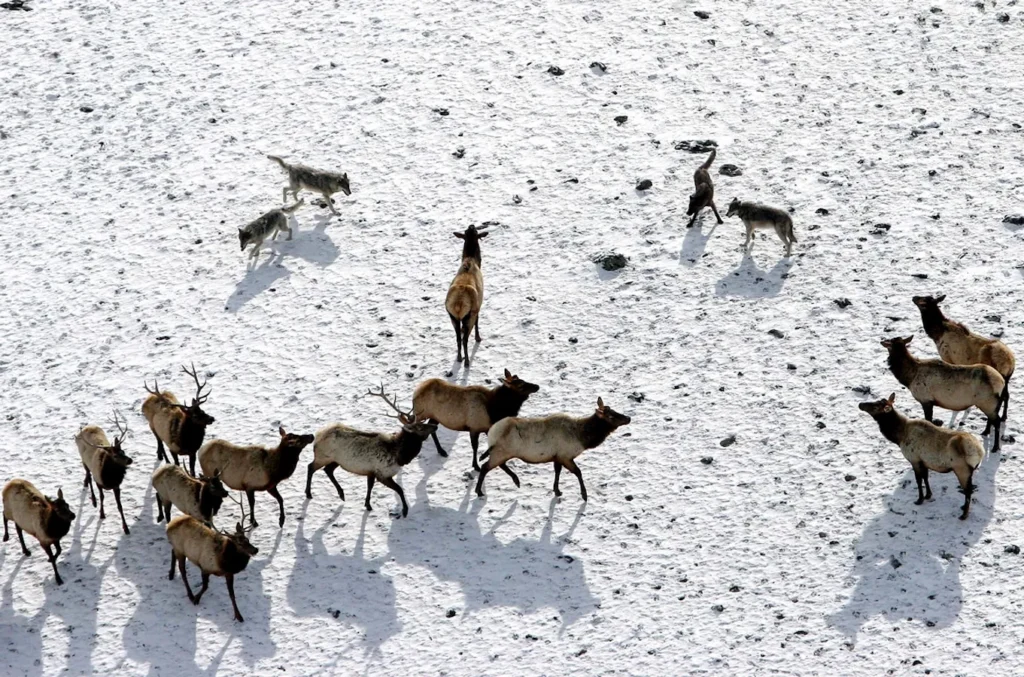
Meanwhile, Lumley the trapper called the decline of southwest Montana elk “the greatest loss of hunting opportunity in the world” during the same legislative hearing he touted killing “a lot of wolves.” Decades before wolf reintroduction, elk were so numerous in the area that Yellowstone sometimes culled thousands of the animals in a single year. Later, the park took a more hands-off approach. Elk hunting outside the park became the primary management tool to deal with the overpopulated ungulates. Locals recall a “firing line” of hunters as elk moved toward winter range outside the park’s protections.
Wolves were a factor — but not the only factor — in the region’s decline in elk numbers. Mountain lions and bears eat elk, too. And so do people. A long-running late-season elk hunt in the Gardiner area also played a role in the elk population’s shrinking size. Despite a drastic decrease in numbers from the days before wolves, elk populations north of Yellowstone still remain at or above the state-set goal for elk numbers. Access to elk is yet another important part of the hunting puzzle. Some hunters say the wary ungulates that remain in the area often take shelter from wolves and hunters alike on private land, making them next to impossible to pursue.
Part of the tension around hunting both wolves and elk also centers on economics. While wolf-watching brings millions of tourist dollars into communities surrounding the park, outfitters north of Yellowstone have lost business as elk herds declined after reintroduction. The lawsuit filed by the Outdoor Heritage Coalition features outfitter Craig Neal, an outfitter in Townsend, Montana, as a plaintiff. Neal, the brief contends, “has been negatively impacted by restrictions on wolf hunting in Montana from a personal and economic perspective … his business opportunities are limited by the insufficient wolf quotas and reduced elk available for hunting.”
Elk aren’t the only hooved creatures wolves impact, either. Outside Yellowstone, they also occasionally kill livestock. Although wolf-killed cattle and sheep are a drop in the bucket among the many factors that kill domestic livestock, the impacts aren’t trivial for individual ranchers in the Greater Yellowstone Ecosystem.
In Wyoming and Montana each year, wolves typically kill at least a few dozen of the more than 3 million cows in the two states — though many ranchers argue that wolf kills can go unproven since remote carcasses are consumed before the kill can be documented. Depredation numbers in Wyoming notably spiked from 2014 to 2017, topping out at 121 wolf-killed cattle — a pulse of conflict that coincided with the three years Wyoming wolves were relisted under the Endangered Species Act. While those federal protections prohibited hunters from killing wolves at the time, wildlife managers trying to avert conflict could do just that. And they did, killing a record number. In Montana, complaints about wolves eating livestock peaked at 233 in 2009. Since then, in the wake of delisting, the number of reports has dropped off drastically, hovering at 100 or fewer annually from 2015 to 2024.
Pressure cooker
To control the wolf population and mitigate their impact, hunting has become a fixture of wolf management in the Northern Rockies. Since legal seasons began earlier in the century, some animals that spend most of the year in Yellowstone are always lost to hunters’ bullets and traps outside park boundaries.
In an attempt to resolve the tension between the park and surrounding states, Montana carved out small areas with more limited hunting called “wolf management units” directly north of the park. Wyoming tightly controls its hunts immediately adjacent to Yellowstone and Grand Teton, and has had minimal overall impact on Yellowstone populations. Idaho takes an aggressive, statewide approach to wolf hunting and trapping, but the topography and location of Yellowstone packs have limited its influence on park populations.
The vast majority of harvested Yellowstone wolves die in Montana, where tensions continue to flare over setting the state’s wolf season. In 2021, the Montana Legislature mandated a reduction in the state’s overall wolf population, numbering roughly 1,177 at the time. The new law simply set a minimum of 15 breeding pairs (corresponding to 450 wolves). In the years since, setting policy to reduce wolf numbers has fallen to the Montana Fish and Wildlife Commission, a citizen board appointed by the governor, currently Gianforte. The commission has considered a slew of ways to meet the mandate: lengthening hunting and trapping seasons, instituting a statewide quota, night hunting on private land, and neck snaring, among other approaches. Some of those aggressive tactics have taken effect. Others haven’t. Yet today, four years after the legislative mandate took effect, Montana still hasn’t seen a meaningful reduction in its wolf population.
In 2021, about six months after Gianforte trapped and killed a Yellowstone wolf north of the park, the commission also removed quotas in the wolf management units, or WMUs, just outside Yellowstone. That winter, hunters killed at least 25 wolves that spent the vast majority of their lives inside the park. Roughly 1 in 5 park wolves perished — more park wolves than in any hunting season before or since. Yellowstone biologists worried about the impact of the hunt on their three-decade-old research project — some packs dissolved due to the hunt, and others formed. Behavior and reproductive rates changed, too. Wildlife guides were furious, concerned they’d lose business or wolf-watching opportunities altogether.
Ultimately, the quotas were restored. But over the next two years, outcomes for Yellowstone wolves only marginally improved. At least 13 park wolves were killed in the 2023-2024 hunting season. Yellowstone Superintendent Cam Sholly voiced his concern to the Montana Fish and Wildlife Commission in a 2024 letter. “Wolves that primarily live within Yellowstone are exceedingly valuable to a great number of people across Montana, the country, and the world,” he wrote. “The park generates hundreds of millions of dollars in additional economic activity to Montana economies and wolves and other wildlife rate as a top reason why people visit the park and region.”
The pressure cooker of hunting policy around Yellowstone hasn’t let off steam. At the January 2025 legislative hearing, Lumley complained that the Fish and Wildlife Commission was setting policy that was too protective of wolves and listening only to out-of-state interests, particularly Yellowstone. Just 3% of the national park lies in Montana. “That’s what you are elected to do, protect Montana’s interests,” Lumley testified. “Not Yellowstone National Park’s.”
In a Fish and Wildlife Commission meeting months later, Chris Morgan, Lumley’s successor at the Montana Trappers Association, made similar claims. He alleged that policy safeguarding wolves in the region around Yellowstone is a “political ploy” and touted the state’s responsibility for wolf reduction rather than wolf watching.
“We don’t have any state mandate that requires us to make sure that ecotourism thrives,” Morgan said. “Our mandate is to reduce the state’s population of wolves. Plain and simple. Period.”
Wolf advocates were just as fired up in the day-long meeting. Cara McGary, a Yellowstone guide and cofounder of Wild Livelihoods Business Coalition, argued that plenty of Yellowstone wolves — like 1331F— die even outside the protective boundaries of the wolf management units. Southwest Montana receives far more wolf hunting pressure than anywhere else in the state, despite a lower overall wolf density than Montana’s northwest corner, according to Montana FWP data. It’s also the only area in the Treasure State where the wolf population was already on the decline. In 2024 alone, at least six wolves from the park died legally in the Yellowstone-adjacent WMUs and another five outside their boundaries. “That’s almost 10% of the product that our businesses depend on,” she testified.
At the time of publication, wolf hunting season in Montana, Wyoming and Idaho is well underway. The heat over wolf hunting regulations around Yellowstone in that August commission meeting led to something of a middle-ground approach. But already this year, a Montana hunter legally killed a Yellowstone wolf beloved to the wolf-watching community, which described the dark black 1479F as playful and tolerant of crowds.
“She was one of the few wolves in the park that would walk right through a crowd of people to reach her destination,” wildlife photographer Deby Dixon told Cowboy State Daily.
The National Park Service has two chief goals: preserving and protecting natural systems, and visitor enjoyment. Wolves figure into both, and the scientific gains from studying Yellowstone packs are unparalleled: They’re both uniquely visible and, at least in theory, uninfluenced by humans. But as wolves deal with such direct mortality when they set paw outside the park, Smith wonders: “Do you have a natural wolf population or not?”
Some data suggests not. A 2023 peer-reviewed study led by then-University of Montana PhD student Brenna Cassidy found that Montana’s wolf-hunting regime has a clear effect on the overall survival of Yellowstone wolves. Without hunting, park wolves have a nearly 90% chance of surviving any given year, but the rate falls to about 80% when hunting occurs with quotas. When there’s unlimited hunting outside the boundary, Yellowstone wolves’ chances of surviving a year dip closer to 70%.
Smith, Yellowstone’s retired wolf biologist, wants to be clear: He’s a hunter as well, and a self-described “gun guy.” At times, though, he worries that all the focus on Yellowstone’s wolves has an overlooked downside. It sucks the air out of the room in wolf management conversations, leaving too little focus on the thousands more wolves in Montana and the rest of the Northern Rockies that don’t have the same vocal proponents as animals in and around the park. Those wolves die too — often very quickly or brutally. In Montana, hunters and trappers can take a total of 458 wolves this season, including six in the WMUs outside Yellowstone and 60 in the larger region where 1331 met her end. There are no limits in Idaho, and it’s a wolf hunting free-for-all in Wyoming’s predator zone, where 1329 died in an illegally monitored trap.
Thinking about intense hunting pressure throughout the Northern Rockies, Smith thinks wildlife managers should consider a bigger question: “Where do wolves get to be wolves?”



